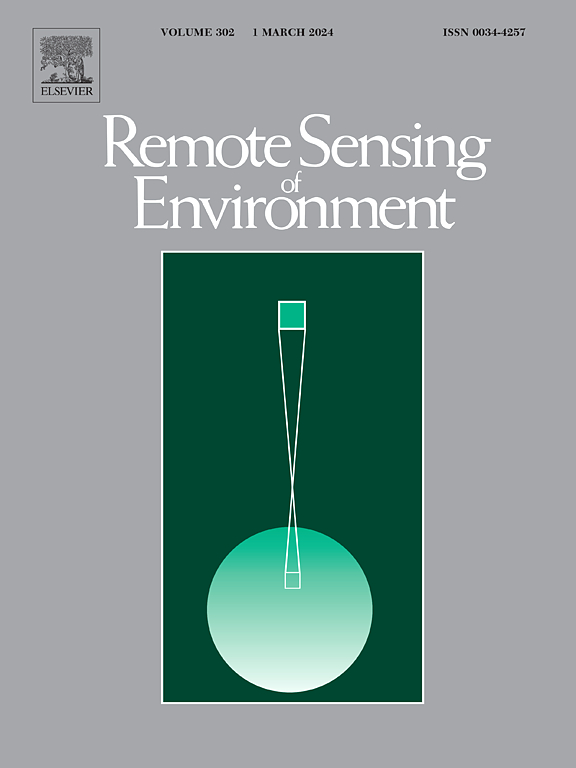Sensitivity of sun-induced chlorophyll fluorescence (SIF) and hyperspectral reflectance to drought response in soybean genotypes with contrasting affinities for arbuscular mycorrhizal fungi
IF 11.1
1区 地球科学
Q1 ENVIRONMENTAL SCIENCES
引用次数: 0
Abstract
Increasing frequency and severity of drought events impact global and domestic agricultural productivity. Monitoring drought in agricultural fields with remote sensing can provide faster, lower-cost decision management support for critical field management activities. We evaluated the application of sun-induced chlorophyll fluorescence (SIF) emitted at red (SIFRed) and far-red (SIFFarRed) wavelengths in comparison with chlorophyll- and xanthophyll-sensitive reflectance-based remote sensing indices (NDVI, NIRV, NIRVP and PRI) for drought stress monitoring at the canopy scale. To do so, we evaluated impacts of drought stress on two soybean varieties with similar phenology but contrasting affinities for arbuscular mycorrhizal fungi (AMF), which can provide host plants with extended access to water and nutrients in exchange for carbohydrates. Drought response physiology of the two genotypes was further explored using leaf level photosynthetic gas exchange, chlorophyll fluorescence, water potential and phenology. We observed distinct responses, with the low-affinity genotype exhibiting lower SIFRed and more negative midday leaf water potential, as well as reduced growth and development rate compared with the high-affinity genotype. SIFFarRed and NIRVP exhibited the strongest correlation with canopy photosynthesis followed by NIRV. We also observed different timing of drought response parameters associated with different remote sensing signals. Our findings demonstrate the particular sensitivity of SIF to physiological drought responses, conferred here through AMF associations in the soil, and provide insight to the physiological drought responses tracked by different remote sensing signals.
太阳诱导的叶绿素荧光(SIF)和高光谱反射对大豆干旱响应的敏感性与丛枝菌根真菌的对比亲和性
日益频繁和严重的干旱事件影响全球和国内的农业生产力。利用遥感监测农田干旱可以为关键的田间管理活动提供更快、成本更低的决策管理支持。在树冠尺度上,通过与叶绿素和叶黄素敏感反射率遥感指数(NDVI、NIRV、NIRVP和PRI)的比较,评价了太阳诱导叶绿素荧光(SIF)在红色(SIFRed)和远红色(SIFFarRed)波长下的应用。为此,我们评估了干旱胁迫对两个物候相似但对丛枝菌根真菌(AMF)亲和力不同的大豆品种的影响。丛枝菌根真菌(AMF)可以为寄主植物提供更多的水和养分以换取碳水化合物。利用叶片光合气体交换、叶绿素荧光、水势和物候等指标进一步探讨了两个基因型的干旱响应生理。与高亲和基因型相比,低亲和基因型表现出更低的SIFRed和更多的负正午叶片水势,并且生长发育速度减慢。SIFFarRed和NIRVP与冠层光合作用的相关性最强,其次是NIRV。我们还观察到不同遥感信号下干旱响应参数的不同时序。我们的研究结果证明了SIF对生理干旱反应的特殊敏感性,通过土壤中的AMF关联,并为不同遥感信号跟踪的生理干旱反应提供了见解。
本文章由计算机程序翻译,如有差异,请以英文原文为准。
求助全文
约1分钟内获得全文
求助全文
来源期刊

Remote Sensing of Environment
环境科学-成像科学与照相技术
CiteScore
25.10
自引率
8.90%
发文量
455
审稿时长
53 days
期刊介绍:
Remote Sensing of Environment (RSE) serves the Earth observation community by disseminating results on the theory, science, applications, and technology that contribute to advancing the field of remote sensing. With a thoroughly interdisciplinary approach, RSE encompasses terrestrial, oceanic, and atmospheric sensing.
The journal emphasizes biophysical and quantitative approaches to remote sensing at local to global scales, covering a diverse range of applications and techniques.
RSE serves as a vital platform for the exchange of knowledge and advancements in the dynamic field of remote sensing.
 求助内容:
求助内容: 应助结果提醒方式:
应助结果提醒方式:


